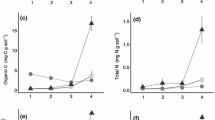Summary
The size of both the denitrifying and the total bacterial population was found to be positively correlated with soil pH, but the denitrifying bacteria were more sensitive to acid environments than the bacterial microflora as a whole. The ecological evidence for a pH effect was supported by studies with individual pure cultures. The estimate of abundance of denitrifying micro-organisms was also affected markedly by the composition of the medium, and an improved medium has been proposed.
Marked differences were noted in the nutrition of the bacteria capable of N2 production. In the absence of oxygen, certain strains developed readily using nitrate as the terminal electron acceptor for growth in media with no preformed growth factors, but others required ammonium or growth factors for denitrification to occur.
Similar content being viewed by others
References
Allen, O. N., Experiments in Soil Bacteriology. Burgess Publishing Co., Minneapolis (1957).
Allison, F. E., The enigma of soil nitrogen balance sheets. Advances in Agron.7, 213–250 (1955).
Baalsrud, K. and Baalsrud, K. S., Studies onThiobacillus denitrificans. Arch. Mikrobiol.20, 34–62 (1954).
Bremner, J. M. and Shaw, K., Denitrification in soil. II. Factors affecting denitrification. J. Agr. Sci.51, 40–52 (1958).
Jensen, H. L., Contributions to the microbiology of Australian soils. I. Numbers of micro-organisms in soil, and their relation to certain external factors. Proc. Linnean Soc. New South Wales59, 101–117 (1934).
Peech, M. and English, L., Rapid microchemical soil tests. Soil Sci.57, 167–195 (1944).
Prescott, S. C., Winslow, C.-E. A., and McCrady, M. H., Water Bacteriology. John Wiley and Sons, New York (1946).
Robinson, J., The effect of salts on the nitritase and lactic acid dehydrogenase ofMicrococcus halodenitrificans. Can. J. Botany30, 155–163 (1952).
Russakova, G. S. and Butkevich, V. S., Denitrification by bacteria without the use of nitrate as nitrogen source (In Russian) Mikrobiologiya10, 137–162 (1941).
Sacharowa, T. M., Die Abhängigkeit der Denitrifikationsgeschwindigkeit von der Reaktion des Mediums. Cent. Bakteriol.11, 65, 15–35 (1925).
Timonin, M. I., Microflora of the rhizosphere in relation to the manganese deficiency of oats. Soil Sci. Soc. Am. Proc.11, 284–292 (1946).
Umbreit, W. W., Burris, R. H., and Stauffer, J. F., Manometric Techniques. Burgess Publishing Co., Minneapolis (1957).
Van Niel, C. B. and Allen, M. B., A note onPseudomonas stutzeri. J. Bacteriol.64, 413–422 (1952).
Verhoeven, W., Aerobic sporeforming nitrate reducing bacteria. Ph. D. Thesis, Delft (1952).
Author information
Authors and Affiliations
Additional information
The investigation was supported in part by funds provided by the Sun Oil Company and Cooperative Regional Research Project NE-39. Present address of senior author: Department of Soils, College of Agriculture, University of Phillippines. A gronomy Paper No. 528.
Rights and permissions
About this article
Cite this article
Valera, C.L., Alexander, M. Nutrition and physiology of denitrifying bacteria. Plant Soil 15, 268–280 (1961). https://doi.org/10.1007/BF01400460
Received:
Issue Date:
DOI: https://doi.org/10.1007/BF01400460




